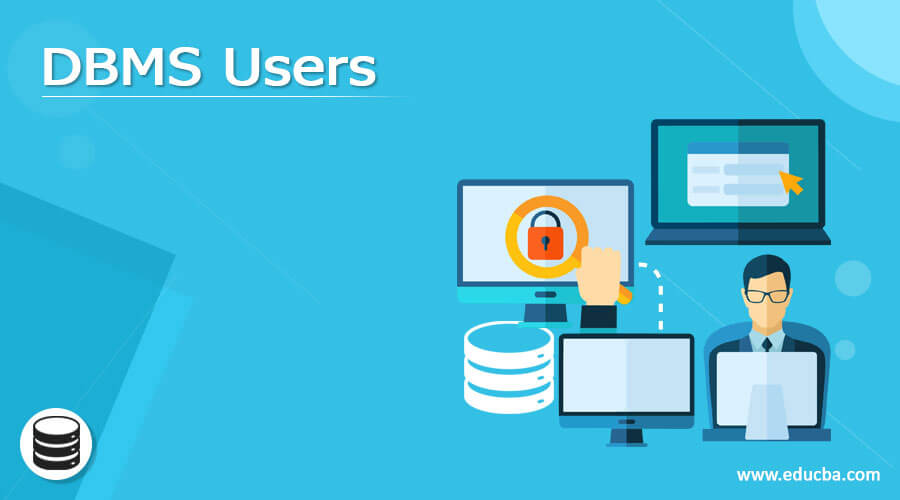Updated June 14, 2023
Who are DBMS Users?
DBMS users generally access the database; it just specifies the different accounts associated with the user. This may require access for the user, and they are the ones who can take advantage of accessing the database and its data. In DBMS, we have different types of users who may have different types of access depending on the requirement.
DBMS categorizes the users based on the access they have to the database. Sometimes it is required to order access to the database because they are particularly associated with the user id of the user and password. In the coming section of the tutorial, we will discuss more about the internal working and different types of users we have in DBMS in detail.
Explain Database Users
DBMS users are very important; with the help of this, we can keep track of the activity on the database. This means if we have performed any operation on it later, we can identify with the user who has made the changes. Also, we can restrict users from using the database if they do not have the required access. I also provide security to our database from being accessed by unauthorized users. In DBMS, we have different types of users that we will discuss later in the tutorial.
Types of DBMS Users
In this part of the tutorial, we will be going to discuss the different types of DBMS users we have in place; we will discuss each of them in detail for better understanding and clarity, so let’s get started to see below;
1. System Analyst
This type of user is responsible for analyzing the requirement of the end-user; they are responsible for checking and verifying if all the requirement of the end-user is satisfying or not. They do all the analysis part of the database regarding the requirement of the end-user needs to be taken care of.
2. Sophisticated Users
This type of user already has familiarity with the database, and they can be business analysts, engineers, or scientists. They have the privilege of developing their database because they are already aware of that. So they are free to design their database according to the requirement. Also, after creating their database, they can easily write queries and fetch their data from the database by using any query processor, etc. If we talk about engineers, they are developers who know about the database; no need to write the program code for it and directly access the database.
3. Parametric End Users
This type of database user is those who do not have any knowledge about the database, but they access the database very frequently in their daily need, like to get the data from the database or their result, etc. To understand this, we can take an example where people from a non-technical background are using an online application to get the result; let’s take an example of a bank employee who uses the bank online application to do all the work, but in actual they are not aware of the internal database it users or where it is string those user data. This type of user, often called a “Parametric user,” requires careful analysis to address their specific requirements.
4. Database Administrator
These are the most important type of users in DBMS because they control the database levels; these are the team or the person who creates and maintains the schema. They are responsible for providing access to any new users if required. They will create the new user and provide them id and password as their credential to allow them to access the database.
Also, they are responsible for supporting the technical team and providing frequent backups for the production server. If the technical team raises any concern, they have to resolve it. They are also responsible for handling data loss, which can be caused by unusual activity, error, or software failure. They continuously monitor the database, provide security, etc. They are often termed as the superuser of the database because they have a DBA account.
5. Temporary Users
This type of user is Temporary, meaning they access the database very little. Not frequent users, but they will access the information they want all the information in place. Let’s say some high-level management people sometimes access it. They are also called casual users who access new information each time.
Database Designers
These are the users responsible for designing the database, which includes various things such as triggers, indexes, schema, constraints, stored procedure, tables, etc., which the complete database. This means these types of users implement the overall design. For example, they are the team or person responsible for deciding which data need to be stored, what type of attribute will be, what kind of relation will exist among the tables, how the records will store, etc. This is an essential part of the database because this data will depend.
Application Programmers
Application Programmers are nothing but computer professionals who know everything in detail. They are often termed as the back-end developers who use the database to store their data inside it. Also, they fetch the data from the database in the later part. Application programmers are very efficient; they can even design and create the database the way they want according to the requirement. They are free to write their code in any language according to requirements.
Conclusion – DBMS Users
All types and their responsibilities are very well defined in the tutorial; this will give us a better idea about the purpose of users in the database and why we require it. Also, we can go with any of them according to our requirements.
Recommended Articles
This is a guide to DBMS Users. Here we discuss Who are DBMS Users and their types for better understanding. You may also have a look at the following articles to learn more –

